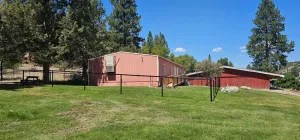Shooting the Breeze: Wood vs. synthetic
Published 1:30 pm Tuesday, July 9, 2019

- Dale Valade
As a young kid growing up in Grant and Wheeler counties, I saw lots of different guns. It seemed everyone in our communities went out each fall to go big game hunting. Nearly everyone in our immediate circle carried a standard caliber, wooden-stocked hunting rifle. The first synthetic stock I ever saw was on Bob Hansen’s .338 Win Mag. What a spectacular rifle! It was a lefty Browning A-Bolt, stainless steel with a BOSS muzzle brake on the end. Besides keeping me in a steady supply of Snickers minis and hunting/shooting periodicals, Bob was a great friend of the family. What I remember most about that rifle was it’s biblical concussion due to the brake.
Trending
Today plastic and fiberglass stocks have really caught on, and in some hunting camps the wooden stock is now the odd one out. While you could flip a coin to decide which may be best, let’s go over the pros and cons of each design.
Wooden stocks have been around since forever. Besides being sturdy, they are truly beautiful. They can require a lot of work to fit and finish, but nevertheless provide a classic, timeless aesthetic to any hunting rifle so adorned. Scratches and dings require a refinish of the entire surface to extricate. Wood being organic is porous and therefore susceptible to changes in temperature and humidity. In extreme climates or continued exposure to wet conditions you can count on your prized wooden stock to warp. A warped stock will not shoot straight in addition to quickly reverting to a cosmetic state resembling driftwood. Still if proper care is taken to keep your stock sealed, especially in the action and barrel channel areas, the problems associated with warping are largely mitigated.
A sort of happy medium between dense hardwood and Tupperware is the laminate stock. These are made by epoxy gluing plies of wood together and then forming a stock from the resultant mass. They come in anything from plain Jane patterns to wacky neon colors. Having the aesthetic appeal of wood and the ruggedness of synthetic, these stocks are truly a great compromise.
Trending
Synthetic stocks really never caught on until the 1980s where their design advantages began to appeal to some, especially those in extreme temperatures and climates. They can range in materials from plastic to rubber to fiberglass. Synthetics will not warp in extreme heat or moisture, and where weight is an issue with walnut stocks (backpack sheep hunting, for example), the synthetic is usually much lighter to carry. Lightweight rifles in heavy calibers produce severe recoil necessitating a muzzle brake to tame. Synthetics can be had in any color or texture. They’re even making them in wood grain these days. Recently chassis-style stocks have caught on, although I find them about as attractive as a handyman jack personally.
From my comparison, one might gather that the synthetic is the winner hands down. Perhaps, if function is truly the ultimate trump card in your deck. Although only then by a slim margin. To paraphrase Frank Jankunis, a gunsmith I knew for years, “Don’t buy ugly guns, because you’ll spend more time looking at them than anything else.” I think beauty here is in the eye of the beholder, but practically speaking, there is room for both designs.
So which way do you vote? Wood or synthetic? Write in to shootingthebreezebme@gmail.com!









